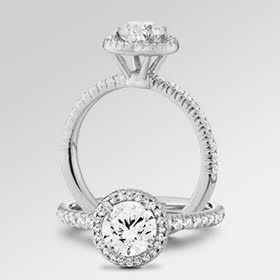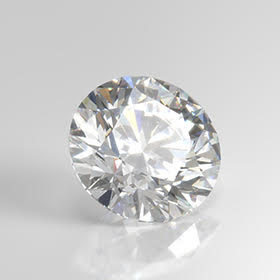The popularity of colored diamonds is on the rise, with diamonds like the Pink Legacy breaking records and making headlines for its recent historic auction sale, along with colored diamond engagement rings being named as a top trend in 2019. One of the reasons that these gorgeously colored stones are being seen more frequently in jewelry is thanks to the advancements in lab-grown diamonds. Because scientists have cracked the code on making brilliant hues in the lab, the mainstream can now afford a colored diamond. The reason that mined colored stones are so expensive is that they are very rare, with only 1 out of 10,000 carats displaying fancy color, and only 1 in 25,000 carats showing intense colors. In this blog, we’ll take a deep dive into how colored
diamonds are categorized and why they’re so rare.
Colorless Diamonds: The Most Rare
It may be surprising to learn that some of the rarest diamonds are colorless diamonds. These are what we typically call white diamonds, even though we are referring to clear diamonds. Even in most traditional white diamonds, there are subtle shades of yellow and brown that reflect in. Because nitrogen, which makes for the yellow hue in diamonds, is the most abundant trace, in most cases, diamonds have a yellow hue. As such, white diamonds are graded on a scale from D-Z, with D being completely devoid of color and Z having the most noticeable color interferences. In D-grade diamonds, color cannot be detected, even with 10x magnification. D-grade diamonds have huge price jumps by carat because the larger the carat, the rarer it becomes. For example, a 1-carat D-color diamond would cost around $15,000, whereas a 2-carat stone would range upward of $80,000! One of the most famous modern D-color diamonds is Kim Kardashian’s engagement ring, a 15-carat whopper that Kanye reportedly spent $8 million on.
When we’re talking about colored diamonds, we aren’t talking about the white diamonds with shades of yellow. We’re talking about pinks, oranges, purples, and other eye-popping hues — which are graded on a completely different scale based on the intensity of color.
Light, Fancy, Vivid, Intense: What’s the Difference?
The scale of colors used by the GIA ranges from the lightest colors (Light) to the deepest hues (Intense). There are 27 various descriptor names for colored diamonds! From the GIA:
“Unlike colorless and near-colorless diamonds, fancy-color diamonds are evaluated less for brilliance or fire and more for color intensity. Shades that are deep and distinct are rated higher than weak or pale shades. GIA describes color in terms of hue, tone and saturation. Hue refers to the diamond’s characteristic color, tone refers to the color’s relative lightness or darkness and saturation refers the color’s depth or strength. Using highly controlled viewing conditions and color comparators, a fancy color grader selects one of 27 hues, then describes tone and saturation with terms such as ‘Fancy Light,’ ‘Fancy Intense,’ and ‘Fancy Vivid.’ The color system GIA developed is used worldwide.”
For some examples of these color differences in our lab-grown diamonds, check out this orange fancy diamond, this fancy-intense orange diamond, and this fancy-vivid orange-pink diamond.
How Colored Diamonds are Made in the Lab
One of the greatest advantages of lab-grown diamonds is the ability to grow gorgeous colored diamonds that can be widely available to the public. In almost all of history, only the wealthiest of humans could afford a colored diamond — but that is no longer the case.
Just like it happens in nature, lab-grown colored diamonds are created by adding trace elements to the growth cell during the growth process. Fascinatingly, various elements are responsible for the different hues that you see. Reminder: a diamond is created from pure carbon, so to be a colorless diamond like we talked about earlier, it must remain flawless in the structure by no trace elements mixing with the carbon. Here’s how the various diamond shades are made:
- Yellow, Brown, and Orange Diamonds: Nitrogen mixes with carbon in order to create the various shades of yellow.
- Blue Diamonds: The element boron is responsible for the beautiful blues seen in the diamond world. The more boron that mixes in with the carbon, the deeper the blue shade becomes.
- Green diamonds: Green diamonds may be the most fascinating of them all, as gamma radiation is responsible for forming the green hue. Here’s how: “Sometimes, the earth where the carbon deposits lie may contain highly radioactive material. A genuine green diamond endures a long history of exposure to atomic radioactivity during its formation underground, sometimes lasting for millions of years. The radiation, usually coming from radioactive uranium, has the ability to displace carbon atoms in the diamond from their positions and changes the rock’s ability to absorb and refract light, allowing it to reflect the green color on its surface. The longer it is exposed to radiation, the more vivid the green color becomes.” And yes, this process can be replicated in a lab! Don’t worry though— despite the radiation, green diamonds are completely harmless.
- Pink and Red diamonds: This is still a bit of a mystery to scientists, but their theory is that pink and red colors are formed due to higher pressure during the formation process. And that’s a pretty strong theory since we can create beautiful pink diamonds using this method in the lab!
The Rarity of Mined Colored Diamonds, by Color
Since we can create all kinds of never-before-seen colors in the lab now, this bit of knowledge only applies to mined diamonds. But just in case you’re curious about which colors are the rarest, here you go, in order from least rare to most rare: yellow, brown, pink, blue, green, black, orange, red.
Ready to start shopping for your own colored diamonds? We have an entire collection of lab-grown colored diamonds to choose from! If you’re looking for diamonds that are already set in jewelry, we also have colored diamond earrings and eternity bands that are sure to stun.










